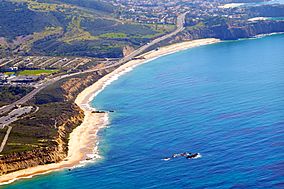Crystal Cove State Park facts for kids
Quick facts for kids Crystal Cove State Park |
|
|---|---|

The beach in Crystal Cove State Park
|
|
| Location | Orange County, California, United States |
| Nearest city | Newport Beach, California |
| Area | 3,936 acres (15.93 km2) |
| Established | 1979 |
| Governing body | California Department of Parks and Recreation |
Crystal Cove State Park is a beautiful state park in California, United States. It has about 3.2 miles (5.1 km) of amazing Pacific coastline. The park also includes wild inland canyons and a special area with old beach houses called the Crystal Cove Historic District. This park is located in Newport Beach.
Crystal Cove is a lovely stretch of coastal cliffs and a beachy area. It sits between the Pacific Coast Highway and the Pacific Ocean. You can find it just north of Laguna Beach. The park covers a huge area of 3,936 acres (1,593 ha). It was officially created in 1979. The entire park has 3 miles (4.8 km) of beaches and tide pools. It also includes a 1,400-acre (570 ha) marine conservation area and an underwater park. There are 400 acres (160 ha) of bluffs and 2,400 acres (970 ha) of canyons too.
Contents
A Look Back in Time
For a very long time, before Spanish missionaries arrived, this area was home to native villages. These villages were built around two natural springs. Later, the land became part of a large ranch called "Rancho San Joaquin."
From Ranch to Park
In 1864, a man named James Irvine bought the ranch. His son, James Irvine II, later inherited the land. He started a company called "The Irvine Company" in 1894. Crystal Cove was a favorite spot for James Irvine II. He let his friends, family, and employees build small cottages there.
Over time, these cottages became more permanent homes. The Irvine Company then offered the owners a choice. They could either move their cottages or let the company lease them. This area became known as the Crystal Cove Community.
Camping and Changes
In 1927, part of the area was leased for a camping site called "Tyrone's Camp." Later, in the 1940s, trailers replaced tents for camping. In 1954, the spot was renamed El Morro. About 290 mobile homes were on the beachfront and inland. Some families lived there for many generations.
In 2006, the California Coastal Commission, which bought the property in 1979, changed the area. The mobile home park was closed. It became a place for day visits and overnight camping. The area was also updated to include a visitors center, dining spots, and museums.
Historic Cottages and Art
The Crystal Cove Historic District is a special part of the park. It is listed on the National Register of Historic Places. This district has 46 beach cottages built in the 1920s and 1930s. Twenty-nine of these cottages have been fixed up. You can even rent 21 of them! A fun fact: the house from the 1988 movie Beaches starring Bette Midler is in Crystal Cove.
Crystal Cove has also inspired many artists. It was a popular place for "plein air" painters. This is a type of landscape painting done outdoors. These early painters captured the beauty of Orange County's coastline. One of the cottages at Crystal Cove is even called "Painter's Cottage" to honor this art.
Fun Things to Do
Crystal Cove is a great place for many outdoor activities.
Beach and Water Activities
The beach is very popular for swimmers and surfers. You can also explore the tide pools and sandy coves. Lifeguards from the California State Parks Lifeguard Service watch over the beach all year. During busy times, like summer, lifeguard towers are staffed.
The waters offshore are a special Marine Conservation Area. This means they are protected to help sea life. It is also an 1,140-acre (460 ha) underwater park. This makes it a fantastic spot for scuba diving and skin diving.
Inland Adventures
Beyond the coast highway, the park has 2,400 acres (970 ha) of undeveloped woodland. This area is perfect for hiking and horseback riding. There are 17 different trails to explore.
Camping Under the Stars
The park also offers camping. There are 34 campsites spread across three backpacking areas. These are called Upper Morro, Lower Moro, and Deer Canyon. You cannot drive to these sites; you have to hike in. Each site can hold up to four people. Pets are not allowed, and you cannot have fires in these backcountry campsites.
Animals of Crystal Cove State Park
Crystal Cove State Park is home to many different animals.
Birds You Might See
About 180 different kinds of birds have been seen in the park. Some birds are there all year, while others visit seasonally. Common birds you might spot include the Turkey Vulture, Mourning Dove, Ring-Billed Gull, and Common Raven. You might also see the Greater Roadrunner, Quail, and House Sparrow.
Reptiles and Amphibians
The park also has about 26 types of reptiles. Ten of these are often seen by visitors. These include the Silvery Legless Lizard, Arboreal Salamander, and Pacific Tree Frog. You might also see snakes like the Red Diamond Rattlesnake, Gopher Snake, and California King Snake. Lizards like the Side-Blotched Lizard, Western Fence Lizard, and San Diego Horned Lizard are also common.
Gallery








